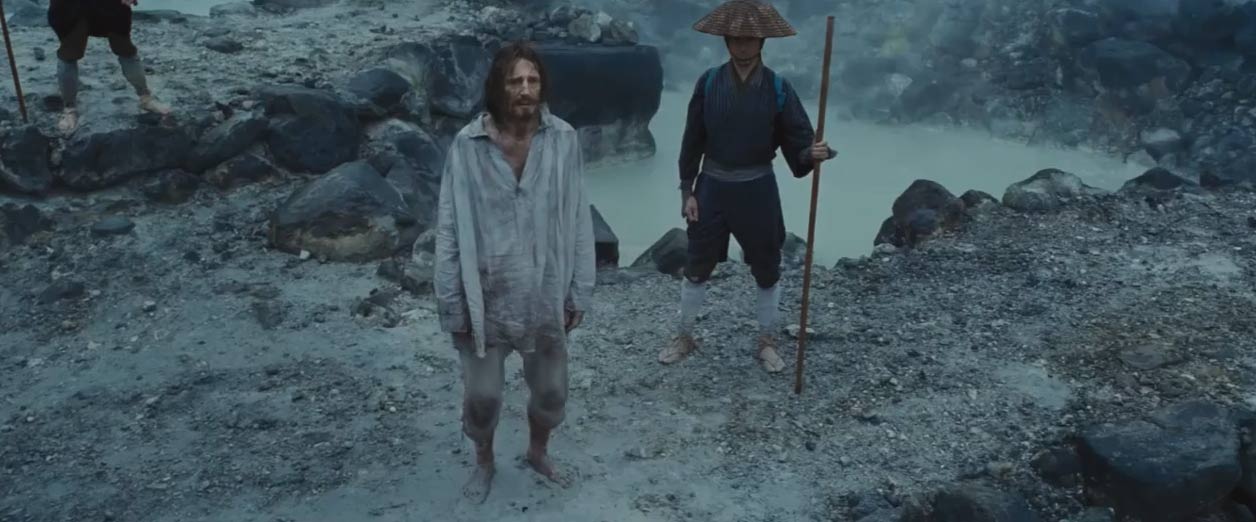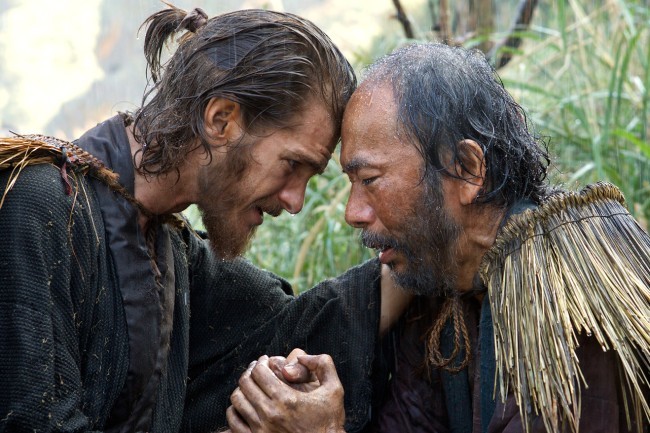“I pray, but I am lost. Am I just praying to silence?”
Thus speaks troubled missionary Father Rodrigues (Andrew Garfield) during Martin Scorsese’s passion project, an adaptation of Shûsaku Endô’s 1966 novel. The tale of two Jesuit priests travelling to Japan in the mid-17th century to find their lost mentor carries a great deal of thematic weight. In an increasingly secular age, there’s something admirable in seeing a director grapple with faith as a theme, particularly when it’s a faith that means much to the director on a personal level. Scorsese had anticipated filming the novel since first reading it shortly after the release of The Last Temptation of Christ, almost three decades ago. As filmed explorations of Christian faith go, few can be as confrontational as Scorsese’s take on Jesus’ passion but, even on its own terms, Silence comes up short. It’s a film that tries to do justice to Endô’s ‘complex simplicity’ (Scorsese’s words), but feels less in control of its own message the further it strays from regular Christian practice, and into the dilemma of apostasy versus martyrdom.
Rodrigues and his colleague Garrupe (Adam Driver) undertake the perilous mission to travel to Japan to continue to spread the faith, and hopefully locate their mentor Father Ferreira (Liam Neeson). From a rainy Portugal, the priests arrive in a foggy and foreboding Japan. The sterling work of DoP Rodrigo Prieto in 35mm rarely allows the priests any clarity or confirmation that their mission is on the right path. If faith is the presence of belief in spite of doubt, the damp landscapes and rugged cliffs that greet the priests should allow it to flourish. The few locals who cling to their now-outlawed Christian faith accept the new priests and the sacraments with relief and quiet joy. These moments in the first half are when the film is strongest; Scorsese ably captures the power of faith when it is inspired in those who need it. The Japanese cast portraying the villagers the priests tend to are marvellous, with the whole community in turmoil about how to hide and protect their new clergy. However, as time goes on and the emphasis shifts from the perseverance of faith to its very survival, Scorsese seems less convinced (and is thus less convincing) of the faith of the clergy.

If the priests are out of their depth, the same may be said of some of the cast. Garfield is perfectly capable of conveying despair but, as Rodrigues is eventually captured and imprisoned, there doesn’t seem to be much variation in Garfield’s portrayal beyond hushed grief. Perhaps he’s too fresh-faced or too broad in his emotions; either way, one can’t help but wonder how the film might have worked had Garfield and Driver switched roles. With a blend of physical devotion (He lost 50 pounds for the role) and a more convincingly-wearied sense of duty, Driver makes a considerable impact as Garrupe, and with less screentime. He probably had more time in the original cut, but even this 160-minute version can’t help but feel over-extended. Driver exits the picture with some time to go, and his absence is sorely felt. We’re left with the imprisoned Garfield going up against his Japanese oppressors, here represented by inquisitor Inoue (Issei Ogata) and his interpreter (Tadanobu Asano). Whether it’s in the writing (Scorsese and Jay Cocks adapted Endô’s text) or the performances, but both come across as cartoonishly camp. It’s hard to make an antagonist convincing when you half-expect them to raise their little fingers to their lips and demand ‘one meeeelllion dollars’ for ransom. Between these guys, and Neeson resurrecting his Ra’s Al Ghul act, the second act drags when the central debate should soar. All the while, a local Christian guide named Kichijiro (Yôsuke Kubozuka) stands in as a constant test for Rodrigues’ faith. Whenever he betrays the priest, Kichijiro seeks absolution from him. This is fine the first couple of times it happens, but his repentance schtick becomes testing for both Rodrigues and the audience as time goes on. With this runtime, one would imagine there’d be scope for a wider examination of faith, missions and the arrogance and/or nobility thereof, yet it opts to reduce its viewpoints to relatively blunt stances. Mies van der Rohe is alleged to have said ‘God is in the details’, but the details feel skimmed over here. There’s suffering aplenty, but the efforts to explain the steadfastness of Rodrigues feel too determined. The source material deals with issues of choice, doubt, and even grapples with the conundrum of cognitive dissonance. Scorsese’s interpretation aims for these heights, but it never quite gets there.
For all Rodrigues and Garrupe’s trials, Silence is a debate for Scorsese first and foremost. While he can convey the pain of external torture and trial, he seems less comfortable with internal tribulations. Over-narration is nothing new for Scorsese, but Silence may be the first time it feels truly excessive. The film feels too determined to explain something as intangible as faith, which makes its prolonged chat and debate feel increasingly unnecessary. It’s an ample opportunity to nod to the Japanese masters that a cinephile like Scorsese might admire, and there are stylistic nods to Kurosawa and Ozu to be found (Interestingly, he claims to have never watched Masahiro Shinoda’s 1971 adaptation of Silence). Yet, for all the searing imagery on offer (A watery crucifixion here, a trial on the charge of practising Christianity there), Silence could stand to be more silent. If God is in the details, you won’t hear Him if you can’t stop to listen.

